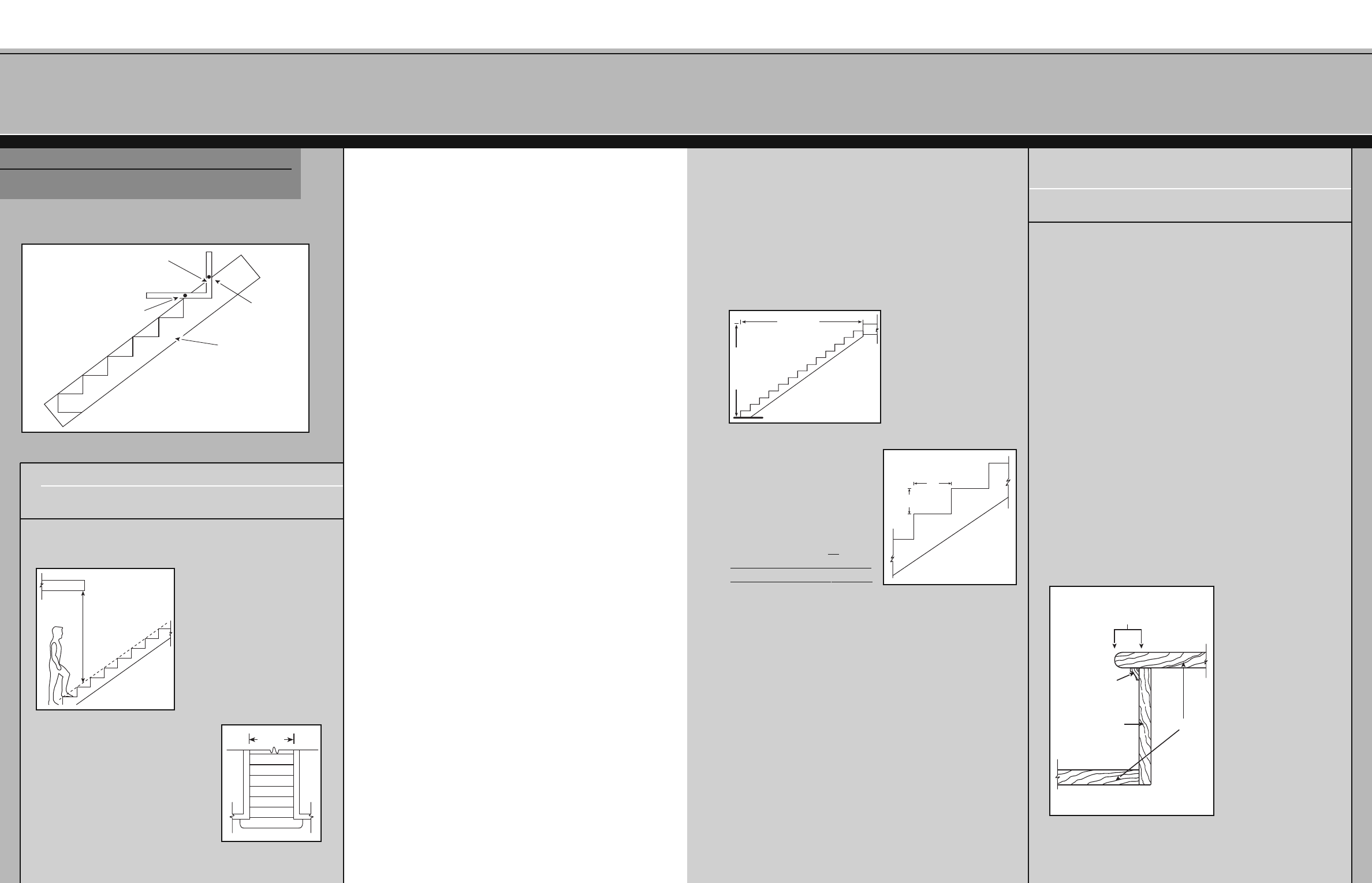Installation Guide

2
SECTION A
S TAIRN OTE
H OW TO C ALCULATE
“RISE” AND “RUN”
1
A solid and durable stairway depends on its support system.
In this section, you will learn how to plan and build the
load-bearing structure that will become the means for
moving people and objects from one level of your building
to the next. Consult a qualified professional for load-
bearing requirements.
Accurate and correct construction of the rough stair
carriage will make it much easier for you to install the
balustrade (Section B).
STEP A.1 – Cut The Stringers
See StairNote One: Planning for Headroom and
Stairway Width
See StairNote Two: How to Calculate “Rise” and “Run”
After referring to StairNote Two: How to Calculate “Rise”
and “Run,” use a framing square, lay out the correct
number of risers and treads on a 2 x 12 (see Fig. 1-1).
Remember that in any stairway, the number of treads is
alw
a
y
s one less t
han the number of risers since a stairway
always begins and ends with a riser.
K
eep in mind also that the nosing on the treads will project
about 1" from the riser and must be kept from interfering
with a door or with passage in a hallway.
The first riser must be cut shorter than the others by the
thickness of the tread (1
1
/32"). Note this will automatically
incr
ease the topmost riser by the same amount, but this will
be made up when the treads are installed.
Cut at least one stringer for each 12 to 18 inches of
stairway width.
See StairNote Three: How to Make a Pitch Block
SECTION A
S TEP
A.1
FIG. 1-1 - Laying out treads and risers on a 2 x 12 stringer
S TAIRN OTE
O NE
P L ANNIN
GFOR
H EADROOM AND W IDTH
Headroom is the distance
measured vertically from the
sloped plane adjoining t
he tread
nosing or from t
he floor sur
f
ace
of the landing or platform to the
under
side of any overhead
obstr
uction. Most s
t
aircases are
comfortable to use if they have
headr
oom of 7'4" or more.
Headroom should ne
v
er be less
than 6'8".
S
t
airw
a
y width is defined as the
Minimum inside clearance width from
handr
ail to handrail or handrail to wall.
The widt
h of y
our s
t
air
w
a
y mus
t allo
w
r
oom for two people to pass on the
s
t
air
s, and f
or bulky fur
niture to be
car
r
ied up and do
wn. W
e r
ecommend at
leas
t 42".
Headroom
Minimum
3'6"
A stairway is a structure designed to aid people in moving safely
from one level to another. You must begin your design by
measuring the total horizontal distance they will travel on the
stairway, OVERALL RUN, and the total vertical distance, (from
finished floor to finished floor),
O
VERALL RISE
. Study Fig. S–2a to
familiarize yourself with this concept.
For the sake of comfort and
safety, you must now divide
the overall rise and overall
run into smaller units that
we will call simply
R
ISE
and
RUN (see Fig. S–2b).
The optimum rise is 7
1
/2", with
8" as a maximum. Optimum run
is 10" or more.
RULE OF THUMB: The sum of run
and rise should equal between
17" and 18". (Example: 7
1
/2" rise
+ 10
1
/4" run = 17
3
/4".) Be
familiar wit
h your local building
code requirements on this point.
N
ow begin by dividing the overall rise by the optimum rise of
7
1
/2".
EXAMPLE: 1
05" ÷ 7
1
/2" = 1
4
Thus your stairway would require 14 risers of 7
1
/2" each to move
someone a vertical distance of 105" (8'9"). It will seldom happen
t
hat y
our risers will work out to exactly 7
1
/2". The necessar
y r
ise
height is det
er
mined b
y dividing t
he o
v
erall rise by the whole
number nearest the number of risers for the optimum rise.
EXAMPLE: 1
0
6
3
/4" o
v
er
all r
ise ÷
7
1
/2"
optimum rise = 14.23
t
hen 1
0
6
3
/4" o
v
er
all rise ÷ 14
(1
4.23 r
ounded do
wn) =
7
5
/8"
necessary rise height.
Since all stairways start and end with a riser, there will always be
one less tread than the number of risers. Thus, on the 14-riser
stairway we have begun planning above, there will be 13 treads.
For an overall run of 133
1
/4", the run will be 10
1
/4".
EXAMPLE: 133
1
/4" overall run ÷ 13 steps = 10
1
/4" run
If you have the space, you
may adjust the overall run
to make the run come
out even. Be careful not
to let it run too far, or
your stairway may
interfere with a door or
obstruct a hallway.
Remember that the treads
will be approximately 1"
deeper than the run (see
Fig. S–2c). Thus, a 10
1
/4"
run will call for an 11
1
/4"
tread, (about
1
/2" for cove
moulding and about
1
/2"
for tread overhang).
Framing square
2 x12 stringer
Angle gauge
set at unit run
Angle gauge
set at unit rise
O
verall run
Overall rise
Run
Rise
Tread
Riser
Cove molding
Tread overhang
(approx. 1"*)
*Check your local
building codes
FIG. S-1a - Stairway headroom
FIG. S-1b - Stairway width
FIG. S-2a - Overall rise and run
FIG. S-2b - Rise and run, fundamental
stairway construction concepts
FIG. S-2c - Cutaway view of
typical tread/riser installation
T WO










